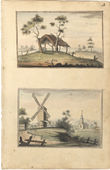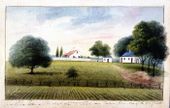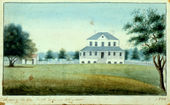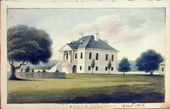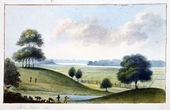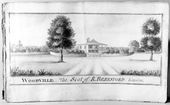Charles Fraser
Charles Fraser (August 20, 1782–October 5, 1860) was an American-born painter of Scottish descent who depicted people and places associated with his native Charleston, South Carolina.
History
Charles Fraser began his art practice as a prolific amateur, producing miniature portraits of family and friends, as well as carefully rendered watercolor depictions of buildings and scenery in and around Charleston. Until the age of 36, he vacillated between art and the legal career he had embarked upon in 1798 while studying law in the office of John Julius Pringle, Attorney General of South Carolina. Called to the South Carolina Bar in 1807, Fraser continued to practice law until 1817 when he finally resolved to become a professional artist.[1]
He had formed his landscape style in the mid-1790s under the tutelage of the view painter and engraver Thomas Coram, who apparently encouraged Fraser to copy European prints and travel guidebook illustrations.[2] Fraser particularly admired the atmospheric landscapes of the 17th-century painters Salvator Rosa and Claude Lorraine, and emulated the picturesque conventions popularized by British writers such as William Gilpin.[3] He was one of the first artists to adapt the British picturesque tradition to the topography of the American South.[4] A sketchbook dating from 1796 to 1806 contains small watercolor depictions of scenes in the vicinity of Charleston that Fraser knew well: manor houses, rice plantations, waterways, monuments, and churches. These included the new plantation house on the Ashley River built by his employer, John Julius Pringle [Fig. 1]; the fabled estate Brabant, owned by his former schoolmaster, Bishop Robert Smith [Fig. 2]; and the country seats established by Fraser’s siblings near Goosecreek on land that had originally formed part of the family plantation, Wigton, named for the Frasers’ ancestral home in Scotland [Fig. 3].[5] In all of these sketches, closely observed details of local terrain, plants, architecture, and social life attest to Fraser’s concern with authentically documenting the appearance of Charleston, notwithstanding his reliance on European landscape conventions.
In 1806 Fraser ventured further afield, making the first of several trips up the eastern seaboard, traveling as far north as Massachusetts.[6] His letters home describe the scenery he encountered in terms that reflect his painterly interests. On his second trip through the northeast in 1816, he observed of northern Connecticut: “The scenery around there is very wild and Picturesque—hills of immense height—broken rocks, etc. make it one of the most striking scenes I ever beheld.”[7] That year Fraser sold “twenty very beautiful drawings of scenes, in different parts of the United States” to the Analectic Magazine, which published eight engravings after his sketches from 1816 to 1818.[8] Despite the financial success of these landscapes, Fraser chose to focus on portrait miniatures when he embarked on his professional career in 1818. By his own calculation, he had produced 350 miniatures by 1837, and it is for these meticulously rendered images of fellow Charlestonians that he is chiefly known today.
In the 1830s, however—with his patrons’ interest in miniatures dwindling and his eyesight in decline—Fraser’s early interest in landscape revived. Rather than the manicured grounds of southern plantations and country seats, however, Fraser now focused on wilderness scenes in New England, romanticized views of European castles, and copies after engravings.[9] His admiration for both the cultivated European landscape and untamed American nature found expression in two poems he published in Magnolia, or Southern Appalachian: “Claude Lorraine” (May 1843) (view text)[10] and “Nature Made for Man” (June 1843).[11] Two years later, he published an essay recounting the history of the garden from Eden to the present day—enthusiastically endorsing the modern style of naturalistic garden design—in the literary miscellany The Charleston Book (view text).[12] With equal passion and similar arguments, he championed the rural cemetery movement in his Address Delivered on the Dedication of Magnolia Cemetery in 1850 (view text).[13]
Fraser was acutely conscious of the momentous changes that had transformed the social and physical fabric of Charleston during his lifetime. He described his companions at a dinner party in 1833 as “a little remnant of the old Stock—which are here and there to be found—like roses of the wilderness—marking ‘where a garden had been.’”[14] In 1853, at the age of 71, he presented his personal recollections before the Conversation Club, describing the Charleston he had known in the early 1790s, when manicured gardens and open greens defined the topography, and the town was still “completely surrounded with remains of its old revolutionary fortifications.”[15] He mentioned several private gardens that had blossomed in the post-Revolutionary era, including those created by the expatriate British nursery- and seedsman Robert Squibb, author of The Gardener’s Calendar for South-Carolina, Georgia, and North-Carolina (1787), and also by Martha Daniell Logan (1704–1779), author of the planting advice column “A Gardener’s Kalendar.”[16]
Fraser wrote proudly of Lt. Gov. William Bull II (1710–1791), who had entertained “the celebrated naturalist [Mark] Catesby at the family seat, at Ashley River, where there is now a majestic avenue of oaks, said to have been planted by his hand” [Fig. 4].[17] In the early 1800s, Fraser had produced several drawings of Ashley Hall, including a representation of the obelisk erected in the garden in 1792 in memory of Gov. Bull [Fig. 5]. Fraser noted a few public gathering spots in Early Republican Charleston, including Gibbes’s Bridge, “where seats and refreshments were provided for the company that used to resort there on warm summer evenings,” and Watson’s Garden, “a beautifully cultivated piece of ground . . . about a mile from the city, adorned with shrubbery and hedges, and fine umbrageous trees.”[18] A bittersweet quality tinges several aspects of Fraser’s account. The Charleston Botanic Society and Garden, founded with high hopes in 1805, had ultimately failed to prosper. Numerous families had broken up their plantations, and “the ruinous remains of many of their seats and mansions . . . are melancholy memorials of bye-gone days.”[19] On the whole, however, Fraser asserted that Charleston had changed for the better. Among other recent “public improvements and embellishments,” he called attention to City Square (1818), “a beautiful walk of shade trees” replacing “mean and densely crowded” buildings that had been “a reproach to the city as well on the score of morals as of taste.”[20]
—Robyn Asleson
Texts
- Fraser, Charles, 1843, “Claude Lorraine” (1845; repr., 1983: 46)[21] back up to History
- “Resplendent in the West, the setting sun
- “Announces day’s departure—not a cloud
- “Fleckers with envious shade his glorious path,
- “Nor veils the dazzling radiance of the scene,
- “As slow he sinks below the landscape’s verge. . . .
- “With classic grace
- “Italia’s scenes portray’d—the sombre arch,
- “The consecrated grove—the slumbering lake,
- “The azure mountains mingling with the sky. . . . .”
- Fraser, Charles, 1845, “Gardening,” (1845; repr. 1983: 166, 168, 173–74, 177)[21] back up to History
- “Amidst the blossoms of Eden, and under the shade of its bowers, did woman receive the breath of life, full of joy and fragrance. . . .
- “From the earliest ages it [gardening] has been contemporary with national prosperity and popular refinement, and has always flourished together with other elegant arts, possessing this decided advantage over some of them, that, whilst they have obtained their acme of improvement, and could advance no further, science is shedding on horticulture the rays of continued and progressive improvement, and encouraging its votaries with a boundless field of research, and daily results of interest and delight. . . .
- “These [the hanging garden of Babylon] were raised in the style of an amphitheatre, on terraces of successive elevation, accessible by flights of steps and supported by immense arches. On these terraces was a sufficient surface of soil for the roots of the largest trees, which flourished there in all the luxuriancy of their native forests, together with the richest variety of flowers and shrubs. The ancient Egyptians, who advanced the arts of civilized life to a degree of refinement which no one can venture to say has been surpassed or equalled in after times, bestowed great care upon their gardens, planning them upon a scale of magnificence, and irrigating them with canals and reservoirs, to ensure a continued luxuriance in their orchards and vineyards. . . .
- “Thus, we see that wealth and luxury have always claimed a garden as the favorite object of prodigal expense. But instead of imitating the simplicity of nature, they have too often disfigured her with the motley inventions of art, and loaded her with ornaments which she abhors; and which, without speech or language, she is constantly reproving, even in the humblest of her productions. It is not in straight walks, clipped hedges, cones and labyrinths, or such caprices, that wealth may successfully employ itself in gardening; but in collecting and naturalizing the kindred productions of various countries and climates, and bringing together, as it were, into one family circle, the scattered members of the same species, in beholding their blended hues, and inhaling their mingled fragrance. In this respect, modern horticulture has a decided advantage over that of antiquity. No one can be a skilful horticulturist, that is unacquainted with botany and other kindred sciences, all of which were unknown to the ancients. Their efforts were practical and experimental; those of the moderns are founded on principle, and directed by a knowledge of the properties of plants and flowers, greatly diversifying the beauty of our gardens, and enlarging the enjoyments of taste. Ours and affinities of plants. The modern horticulturist does not merely regard the ornamental part of gardening, which is very much a matter of taste and observation, but without neglecting that, he has higher objects. He calls Botany and Chemistry to his aid. . . .
- “One of the results, we might say one of the triumphs of modern horticulture, is the introduction and naturalisation, even the domestication, of foreign vegetable population is thus greatly increased, and like that of our municipal and political communities, is fast rivalling the number of natives. The extension of commerce, and the growing civilisation of the world, have very much contributed to this. We may all remember when our gardens produced a comparative meagre display, when our roses were few, and those the descendants of the Huguenot stock: and our flower-beds confined to anemonies and stock gillyflowers—pinks, jonquils, and a few blue hyacinths (other colors being very rarely seen), as prescribed by the old-fashioned vocabulary. Whereas they now exhibit a splendid array of flowers and shrubs; contributed by every part of the globe. . . . Exotics are now familiar to us, and may be fairly enrolled in the American Flora.”
- Fraser, Charles, November 19, 1850, Address Delivered on the Dedication of Magnolia Cemetery (1850: 6, 7, 18, 19–20, 22)[22] back up to History
- “And where, with all its edifying attributes, could a cemetery be more appropriately located, than amidst the tranquil scenes of nature? Where could its mute eloquence be more emphatic and salutary? Hence the contrast that there always must be between the repose and seclusion of a rural cemetery and that of a crowded city, surrounded by the parade and the levities of fashion, by the noise and bustle of business, and too often desecrated by the jests of the heedless and profligate. Over the one, nature loves to breathe her sweetest harmonies, and to shed her balmiest dews; whilst the other is beset with every association that can repel thought and meditation. . . .
- “The temples and obelisks and pillars, and other costly structures of former times, were as much the monuments of living vanity as of departed worth—But the taste of the present day is to invite contemplation, with all its soothing influence, by some modest memorial of the departed, more eloquent in its appeals to the heart than the proudest monument—to exchange the crowded church-yards of cities, whose associations, beyond the claims of private feeling, are neither pleasing nor profitable, for the quiet and secluded walks of a rural cemetery, where the mourner may withdraw, and indulge, unseen, the luxury of grief. . . .
- “The establishment of Mount Auburn was an era of taste in our country, at least, as applicable to such an object, for the cemeteries of earlier date were plain, and without any pretension to sylvan decoration. Since then, almost all our chief cities have introduced rural cemeteries into their neighborhood, recommended, as it is said, by similar advantages of situation and embellishment. . . .
- “You have been happy, in a section of country not remarkable for any variety of scenery, or for any striking features of landscape beauty, in having selected a site capable of every improvement required for the use to which it is to be appropriated. Like the unsullied canvass, inviting the creations of fancy from the pencil of the artist, a wide field, in almost original simplicity, is here spread before you by the hand of nature, and requiring only the adornments of taste to carry out her design of beauty. Greater undulation of surface would scarcely be desirable, it being already sufficiently varied to favor the meandering course of the water, which flows beneath yon moss-hung oaks, even to the limits of your enclosure. There we behold a neat funeral chapel, lifting its gothic tower above the trees that embower it, with its deep-toned bell always ready to welcome the "stranger and sojourner" to this mansion of rest.
- “Nor can we be indifferent to the prospects which attract the eye on every side. . . .
- “Let imagination look forward but a few years, to the scenes which these spreading lawns will exhibit. Amidst the luxuriant evergreens that will then shade them, the rich shrubs, and vines, and rose trees, that shall embellish them, here and there will be seen an urn—an obelisk—a broken column, looking out from their drapery of verdure.”
- Fraser, Charles, 1853, describing the city of Charleston (1854: 25–28)[23]
- “There was a word then [1807], and for some years afterwards, known in our topography, now no longer used, to wit: a green—to denote large, vacant spaces along the margin of the town. . . . There was Bouquet’s green, immediaterly in front of the house lately occupied by John Hume, Esq., and extending to the west and south-west to tide water; Harleston’s green, extending north of it to a considerable distance; then a large space immediately west of the Poor-house square, used as a negro burial ground, where the old magazine stood, to which the present Magazine-street led directly.
- “I must not omit to mention Gadsden’s green, which was a large vacant space surrounding the residence of General Gadsden, with a portico in front, which used to be the favourite seat of its venerable owner in summer. . . .
- “There was Savage’s green at the lower end of Broad-street, which . . . was entirely vacant, and spacious enough to be used for military exercise. The old battalion often paraded and fired their pieces there. . . . There was also a green at the lower end of Broad-street, covering the present site of Mr. Trapman’s lot, and part of Mrs. Khone’s garden. The first circus we ever had in Charleston was put up there by a rider named Poole. . . . Then there was Federal green, a large vacant lot in the north-east part of the town, adjoining Colonel Laurens’s garden—which garden occupied the entire square enclosed by the Bay, Society, and Anson-streets. The only existing memorial of the locality of Federal green is Wall-street, as I remember a brick wall that ran along one of the sides of it, from which it, no doubt, took its name, as College and Green-streets are now the only memorial of our old College green.
- “There was another vacant lot or green, on the south side of Tradd-street. . . . It was said to have been used, after the surrender of Charleston, as a parade ground for the Hessians.”
Images
Charles Fraser, The Seat of John Julius Pringle, Esquire, on the Ashley River, 1800.
Other Resources
Library of Congress Authority File
Notes
- ↑ Martha R. Severens and Charles L. Wyrick Jr., eds., Charles Fraser of Charleston: Essays on the Man, His Art and His Times (Charleston, SC: Carolina Art Association, 1983), 16, view on Zotero.
- ↑ Roberta Kefalos, “Landscapes of Thomas Coram and Charles Fraser,” American Art Review (May/June 1998): 122–27, view on Zotero.
- ↑ Severens and Wyrick 1983, 22, 31, 76–78, 84–86, view on Zotero.
- ↑ Roberta Sokolitz, “Picturing the Plantation,” in Landscape of Slavery: The Plantation in American Art, ed. Angela E. Mack and Stephen G. Hoffius (Columbia: University of South Carolina, 2008), 30, 39, 45, view on Zotero; Kefalos 1998, 122–27, view on Zotero.
- ↑ Severens and Wyrick 1983, 77–78, view on Zotero; Charles Fraser and Alice R. Huger Smith, A Charleston Sketchbook, 1796–1806 (Rutland, VT: Charles E. Tuttle Company for the Carolina Art Association, 1959), 8, 18, 19, 21, 38, view on Zotero.
- ↑ Severens and Wyrick 1983, 16–17, 32, view on Zotero; Anna Wells Rutledge, Artists in the Life of Charleston: Through Colony and State, from Restoration to Reconstruction (Philadelphia: American Philosophical Society, 1949), 133–34, view on Zotero.
- ↑ Severens and Wyrick 1983, 87, view on Zotero.
- ↑ Anonymous, “Domestic Literature and Fine Arts,” Analectic Magazine and Naval Chronicle 8 (1816): 453, view on Zotero.
- ↑ Severens and Wyrick 1983, 57–74, 75–76, view on Zotero.
- ↑ Charles Fraser, “Claude Lorraine,” Magnolia, or Southern Appalachian 2 (May 1843): 315, republished in William Gilmore Simms, ed., The Charleston Book: A Miscellany in Prose and Verse (1845; repr., Spartansburg, SC: Reprint Company, 1983), 46, view on Zotero.
- ↑ Charles Fraser, “Nature Made for Man,” Magnolia, or Southern Appalachian 2 (June 1843): 383, republished in Simms 1983, 332, view on Zotero.
- ↑ Charles Fraser, “Gardening,” in Simms 1983, 165–80, view on Zotero.
- ↑ Charles Fraser, Address Delivered on the Dedication of Magnolia Cemetery, 19th November 1850 (Charleston, SC: Steam-Press of Walker and James, 1850), view on Zotero.
- ↑ Fraser’s letter to Hugh Swinton Legare, January 30, 1833, quoted in Severens and Wyrick 1983, 35, view on Zotero.
- ↑ Charles Fraser, Reminiscences of Charleston (Charleston, SC: J. Russell, 1854), 21, 25–28, view on Zotero.
- ↑ Fraser 1854, 25–27, view on Zotero.
- ↑ Fraser 1854, 68, view on Zotero.
- ↑ Fraser 1854, 64, view on Zotero.
- ↑ Fraser 1854, 58, 67 view on Zotero.
- ↑ Fraser 1854, 3, 116, view on Zotero.
- ↑ 21.0 21.1 Simms 1983, view on Zotero.
- ↑ Fraser 1850, view on Zotero.
- ↑ Fraser 1854, view on Zotero.





